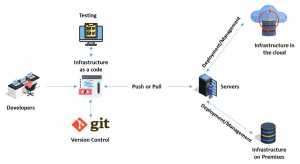
Infrastructure as a Code emerged because managing a server or two has been a full-time job for decades. System managers must carefully curate their vital systems to ensure that their continued operation made the organization operate smoothly. In the last ten years, the way corporations handle their vital Infrastructure has been revolutionized. Anything that is held in a dim, cold space in the basement is no longer a server. Today, cloud services like Google or Amazon handle essential business technology for thousands of customers in huge data centers.
By that, I mean, combined with the emergence of DevOps and agile techniques, many innovations such as virtualization and the cloud have drastically shortened software development cycles. As a result, there was a need for better strategies for maintaining Infrastructure.
The way engineers handle. Infrastructure has altered this change. To achieve vital business objectives, today’s engineers can need a dozen or a hundred servers. This scale change often changes the way that engineers ensure their devices are correctly calibrated. You may have learned of new ways in which environments such as DevOps or Site Reliability Engineering are handled. The idea of these modern environment management strategies is based on Infrastructure as a code, and all sorts of workers take advantage of it.
One way to increase the level of infrastructure management and time to implementation is Infrastructure as Code. IaC can securely build and configure infrastructure elements in seconds using various software, languages, protocols, and processes.
Why Infrastructure as a Code?
Infrastructure as a Code solves three major problems of manually set up infrastructures, namely,
- High price: Configuring each IT environment manually is costly. When setting up the hardware and software, you need dedicated engineers. Supervisors are needed by network and hardware technicians, so there is more overhead management. With Infrastructure as Code, an ecosystem is set up by a centrally controlled tool. You pay for the resources you use, and you can scale up and down your resources easily.
- Environment Inconsistencies: Whenever multiple individuals deploy configurations manually, inconsistencies are bound to occur. It gets hard to map and replicate the same environments over time. These discrepancies result in crucial differences between the environments of growth, QA, and output. In the end, variations in settings ultimately trigger problems with deployment. Infrastructure as a Code ensures consistency as environments are automatically provided and configured without space for human error.
- Slow Installs: To set up an infrastructure manually, engineers first need to rack up the servers. They then configure the hardware and network to the appropriate settings manually. Only then will engineers begin to fulfill the operating system and the hosted application specifications. This cycle is time-consuming and vulnerable to errors. IaC decreases the time for setup to minutes and automates the operation.
Importance of IaC in DevOps
For DevOps, Infrastructure as a code is important. Agile processes and automation are only feasible if the IT infrastructure is readily available for running and checking the code. DevOps teams are enjoying improved testing with IaC, faster recovery times, and more predictable deployments. For quick-paced software delivery, these factors are critical. Uniform IT environments lower the chances of vulnerabilities emerging in the DevOps pipeline.
As DevOps teams include all aspects of the required Infrastructure, the IaC approach has no limitations. Engineers build servers, deploy operating systems, containers, configure databases, configure data storage, networks, and integrate components. With CI/CD software, IaC can be incorporated as well. The code will automatically switch app versions from one environment to another with the right configuration for testing purposes.
To summarize, let me tell you in layman terms, using a table,
| DevOps without IaC | DevOps with IaC |
| Manual setup phases for each deployment | Codes are used to specify configurations and reused them. |
| Teardowns and deployments are slow | Teardowns and deployments are instant |
| Setups (hardware and software) are prone to errors | Setups are stored in version control. |
| Best practices are documented | Best practices are written inside the code |
| Troubleshooting and manual work is required for rollbacks | Simple and instant rollbacks |
What is Infrastructure as a Code?
Let me tell you the formal definition of IaC first. Infrastructure as Code (IaC) is a mixture of principles, procedures, tools, and processes for code and another machine-readable file provisioning, configuration, and computer infrastructure management.
As code (IaC from here on in), infrastructure is how engineers identify their code needs to run computer systems. Most commonly, to describe their Infrastructure, these engineers use a system like Chef or Ansible, or Puppet. In this case, the instrument used is not relevant since they all function similarly. Each enables an engineer to identify the computer system or network of computer systems required for their code to be run and supported.
Beyond doubt, cloud computing has had a significant effect on how organizations develop, manage, and scale products and services related to technology and industry. And the ability to render servers, databases, and other infrastructure-related items accessible has improved productivity levels. However, human error, particularly as long as manual processes are still around, cannot be removed.
When you launch the cloud infrastructure using the web app plugin keys, you should also expect human errors and defects. If we can apply a degree of automation to the entire Infrastructure, the only way to solve these issues is to. And that’s where IaC comes into the frame, exactly. It easily launches cloud foundations automatically, without any human mistakes. That alone has propelled IaC to the top of the technical choices for its operations that companies and corporations consider.
The management of web applications is a popular use case for IaC libraries, but IaC is useful for all applications. Today, many apps are complex and require a load balancer, one or more web servers, database servers, and queues processing systems. A system administrator spends hours supplying these interlocking devices and maintaining them.
This time window is reduced by IaC to mere minutes and usually happens automatically! Engineers identify the basic building blocks required for their application, and the IaC framework does the job of correctly shaping the environment. The system does this by provisioning virtual servers, downloading software packages, creating users.
How IaC works?
With the help of IAC, Infrastructure takes the form of a code file. Since it’s just a text file, it is easy to copy, edit. Remember to put it under the source code file like the rest of the files.
Say, for example, If I have to configure 50 infrastructure at the client’s end, I cannot do it individually, right!! So, here IAC comes into the picture. I program my Infrastructure in one master laptop, i.e., developer’s laptop, and store it in Infrastructure as a code format. Now, it is easy to implement this right!!
So guys, let’s understand this better with the diagram. As I told you, the developer configures the Infrastructure in the form of a file with code stored in the Git repository, a version control tool, as we discussed earlier. Then, It is sent for testing to check for bugs.
If there are no bugs, it is pushed on-to the servers either deployed into cloud infrastructure or in-premise Infrastructure. To get some information from the infrastructures, we use the pull command as shown in the diagram.
IAC works based on two main approaches,
- The imperative approach that describes a set of commands or instructions so that the Infrastructure can achieve the outcome
- The declarative approach explicitly defines the sequence of steps the infrastructure needs to reach the final result, which helps you to see how your final result looks like
Chef, Ansible, Puppet are some of the famous tools used.
Types of IaC
Developers can choose from four main types of IaC, namely,
- Scripting: The most direct path to IaC is writing scripts. Ad-hoc scripts are best for quick, short, or one-off tasks to be performed. However, it’s safer to use a more advanced solution for complicated setups.
- Configuration management tools: These are advanced tools designed to handle applications, also known as code configuration. Normally, they concentrate on downloading and configuring servers. The Cook, the Puppet, and the Ansible are examples of these instruments.
- Provisioning tools: Tools for provisioning concentrate on infrastructure creation. Developers can describe exact infrastructure components using these types of tools. Terraform, AWS Cloud Formation, and OpenStack Heat are all examples of this.
- Containers and templating tools: These tools create pre-loaded templates or images with all the libraries and components necessary for running an application. It is easy to distribute containerized workloads and has a much lower overhead than running a full-size server. Docker, rkt, Vagrant, and Packer are examples.
Principles of IaC
A few have been able to master the art of doing it without much difficulty in the years after businesses have adopted IaC. In other words, only a few organizations have succeeded in discovering the correct tactical approach to suit their framework with the principles of IaC. So, it’s clear that there are a few incorrect ways to apply IaC, and tragedy is the end product of those ways. Many specialists in change management normally try to fit IaC into their legacy and last-generation instruments. You will have to obey those standards to resolve these issues,
- Easy reproducibility of the systems: IaC should allow you to rebuild any given chunk of an infrastructure painlessly. This eliminates the uncertainty that may come in the form of danger or doubtfulness. And when it comes to delivering new services and environments, IaC builds trust.
- High-level flexibility: There’s a need to ensure that all the questions your program asks have the answers to your Infrastructure. Such questions may be about several topics, ranging from the desired storage, linked network compatibility, and configuration. As versatile blocks that can be immediately assembled if and when the requirements occur, IaC should present itself.
- Dynamic Design: Although it’s always a sure bet that a change in the form of an upgrade would require some part or another, it’s not always easy to make those improvements to the current structure. We can’t predict how a system’s requirements may change over time. That’s why one of IaC’s fundamental concepts is that there is always a shift in the design. So to be as lucid as possible, you can build your Infrastructure and applications.
Tools used in IaC
Puppet:
For IaC setup and automation, Puppet takes a more holistic approach. For many big businesses, such as Reddit, Dell, and Google, this tool operates the data centers and runs on all OS systems. It has one of the most sophisticated interfaces on this list, too. This tool uses DSL based on Ruby as the primary language for defining the Infrastructure’s desired end state.
Then the Puppet will work out the best way for you to reach the end state. It also tracks the system for any modifications that deviate away from the specified end state. It corrects those modifications automatically. This is a tool designed exclusively for system managers which offer substantial business and community support for credit.
Chef:
Among CI/CD professionals, Chef is a fairly common IaC method. It uses DSL based on Ruby, and this is definitely a big plus. From the outset, it has “cookbook” versions and helps you to maintain a consistent setup. Even when the Infrastructure has to keep up with the rapid development of the app that it hosts, this is possible.
At the center of its nature, the Chef offers recipes and cookbooks. There are self-styled template appellations and template sets you can use out of the box. A single task should usually be connected to one cookbook, but it can offer various server configurations depending on the resources involved. Chef also fits very well with other IaC platforms, including Terraform and many other cloud environments, since it supports cloud provisioning APIs.
Ansible:
Ansible is a system constructed from the beginning with the perspective of automation. This tool focuses on providing the configuration language “radically simple” and handling cloud instances instantly without modifications. It is also useful for arbitrary IT orchestration, such as zero downtime rolling changes, hotfixes, and so on, instead of being fundamental configuration management. You only explain how components and the system, in general, communicate with each other instead of handling systems as individual units, and Ansible can handle the rest.
Right now, Ansible is also one of the most versatile IaC resources on the market. You are not confined to the characteristics it offers. Instead, you can create your own modules and routines to suit particular needs. For setup and control, it also has an elegant Interface.
Azure Resource Manager:
Using this tool, users can provide Infrastructure and manage dependencies through Azure Resource Manager templates in one seamless cycle (ARM templates). In JSON, the resources that your template uses are defined declaratively to build complete project environments.
To visually track all your builds and updates, use a VSTS dashboard and get a quick overview of your settings’ overall health and your models’ consistency. The Resource Manager also supports the aggregation of instances of servers together with community centralized management.
Benefits of IaC
Now let’s see some of the benefits of IAC,
- Sometimes, manual procedures result in errors. No matter how hard you try, manual infrastructure maintenance can result in inconsistencies. By making the config files themselves be the only source of fact, IaC solves the problem. That way, you ensure that the same settings are deployed over and over again, without inconsistencies.
- One of the key advantages of IaC is, without a doubt, the reduction in infrastructure maintenance costs. You significantly reduce the costs by employing cloud computing along with IaC. That’s because you don’t have to spend money on machinery, hire people to run it, and build or lease physical space to store it.
- The first important advantage that IaC provides is speed. With Infrastructure as code, by running a script, you can easily set up your complete Infrastructure. For every setting, from growth to development, through staging, QA, and more, you can do that.
- The modifications each configuration has undergone are entirely traceable—no more games of guessing on who did what and when.
- IaC can make the entire lifecycle of software development more effective. You can deploy the infrastructure architectures in several phases by employing Infrastructure as code. That makes the life cycle of entire software development more effective, raising the team’s productivity to new levels.
IaC best practices
- Use little or no Documentation: In configuration files, define specifications and parameters. Additional documentation that gets out of step with the configurations in use is not required.
- Version control all configuration files: Place all your configuration files under the control of the source. When handling technology, versioning gives flexibility and accountability. It also allows previous manifests to be monitored, controlled, and restored.
- Constantly test Configurations: Until moving any changes to output, test, and control environments. Consider setting up automated tests to run if the configuration code gets altered to save time.
- Modular approach: Divide the Infrastructure into different components and then, by automation, merge them. The segmentation of IaC provides many benefits. You also restrict the number of modifications to manifests that can be made.
Conclusion
That’s it, Folks !! I hope you found the “Infrastructure as a Code” blog interesting. Please share your thoughts in the comment section of the “Infrastructure as a Code” blog. Now that you have Understood What IaC is, how it works, popular tools, and to learn more about IaC and DevOps methodology, you should consider pursuing a popular DevOps Training Course from Invensis Learning.

















